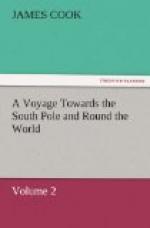Being now but a few miles to windward of the low isles lying off the Foreland, mentioned on the 25th and 26th, I bore down to the one next to us. As we drew near it, I perceived that it was unconnected with the neighbouring shoals, and that it is probable we might get to an anchor under its lee or west side. We therefore stood on, being conducted by an officer at the mast-head; and after hauling round the point of the reef which surrounds the isle, we attempted to ply to windward, in order to get nearer the shore. Another reef to the north confined us to a narrow channel, through which ran a current against us, that rendered this attempt fruitless; so that we were obliged to anchor in thirty-nine fathoms water, the bottom fine coral sand; the isle bearing W. by N. one mile distant. As soon as this was done, we hoisted out a boat, in which I went on ashore, accompanied by the botanists. We found the tall trees to be a kind of spruce pine, very proper for spars, of which we were in want. After making this discovery, I hastened on board in order to have more time after dinner, when I landed again with two boats, accompanied by several of the officers and gentlemen, having with us the carpenter and some of his crew, to cut down such trees as were wanting. While this was doing I took the bearings of several lands round. The hill on the Isle of Pines bore S. 59 30’ E; the low point of Queen Charlotte’s Foreland N. 14 deg. 30’ W.; the high land over it, seen over two low isles, N. 20 deg. W.; and the most advanced point of land to the west, bore west, half a point south, distant six or seven leagues. We had, from several bearings, ascertained the true direction of the coast from the foreland to this point, which I shall distinguish by the name of Prince of Wales’s Foreland. It is situated in the latitude of 22 deg. 29’ S., longitude 166 deg. 57’ E., is of considerable height, and, when it first appears above the horizon, looks like an island. From this cape, the coast trended nearly N.W. This was rather too northerly a direction to join that part which we saw from the hills of Balade. But as it was very high land which opened off the cape in that direction, it is very probable that lower land, which we could not see, opened sooner; or else the coast more to the N.W. takes a more westerly direction, in the same manner as the N.E. coast. Be this as it may, we pretty well know the extent of the land, by having it confined within certain limits. However, I still entertained hopes of seeing more of it, but was disappointed.
The little isle upon which we landed, is a mere sandbank, not exceeding three-fourths of a mile in circuit, and on it, besides these pines, grew the Etoa-tree of Otaheite, and a variety of other trees, shrubs, and plants. These gave sufficient employment to our botanists, all the time we stayed upon it, and occasioned my calling it Botany Isle. On it were several water-snakes, some pigeons, and doves, seemingly different from any we had seen. One




